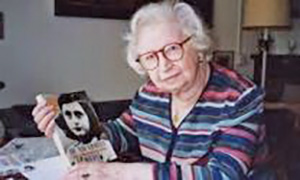
We are all familiar with the story of Anne Frank, the Jewish teenager whose diary was published posthumously after her death in a Nazi concentration camp. Her adolescent writings of her thoughts and dreams penned while hiding from the Nazis became a global bestselling book, spawned a theatrical play, and an Oscar-winning movie. We know a great deal about Anne, her family, and the people who were in hiding with her, but what do we know about the woman who was instrumental in hiding them?
“A Small Light,” a miniseries available on Disney+, Hulu and the National Geographic channel, is the fact-inspired fictionalized story of Miep Gies, the brave woman who was one of the key people integral to hiding the Frank family and others. The focus of the miniseries is on Gies, but other people employed by Otto Frank also participated in keeping the residents of the annex a secret from the outside world. Periodically, the story flashes back to pre-war times and the relationships between Otto, his family and Gies. The apparent close friendships make it easily understandable that Gies would do what she could to ensure their safety.

A disclaimer at the beginning of each episode notes that “Certain incidents, locations and characters have been created or altered for dramatic purposes.” There were a few puzzling scenes with exterior shots of stores in Nazi-occupied Amsterdam that had signs offering their wares in English, and the inclusion of some characters in the story were baffling. Astute viewers will likely guess which parts have been altered, but the overall impact of the story remains powerful and riveting. (For those who want to keep score, see the website History vs. Hollywood at www.historyvshollywood.com/reelfaces/a-small-light.)
Gies was a natural fit to be hired by Otto for his business that had recently relocated from Germany to Amsterdam. Having been brought from Vienna to the Netherlands as a child, her fluency in both German and Dutch helped him in his business and assisted in acclimating his family to their new country of residence. Otto began to see that the illusion of safety in Amsterdam was fading and began preparations for a hiding place in a series of secret rooms at the rear of his factory. With conditions rapidly deteriorating for the city’s Jewish citizens, he asked Gies if she would help hide his family. Gies replied in the affirmative without reservation. Circumstances required their entry into hiding prior to the completion of their readiness plans.
Despite personal hardships and city-wide food shortages, Gies helped the Frank family and several others hide in an annex attached to the factory for two years until they were discovered on Aug. 4, 1944, and promptly deported to concentration camps.
The list of suspects who exposed the hiding place to the Nazis is long, and a definitive answer is still unknown. The series presents local merchants, other employees of the company, a blackmailer, and neighbors as possibilities. The answer is still unclear to this day.
With Jewish property subject to Nazi confiscation, Gies managed to go through the annex to find items of value to secure until the Frank family could return. Having heard the Dutch queen speak on the radio about keeping a diary, Anne began to write a second “sanitized” diary version that could be read by other people. Gies gathered both sets of documents and hid them before ultimately handing them to Anne’s father upon his return.
 The Netherlands were officially neutral during the war, not taking an official stand on Germany. The resistance to the Nazis was slow to rise and mostly non-violent, with a number of resistance groups specializing in saving Jewish children. Interestingly, previous to WWII there was extreme friction between the Catholic and Dutch reformed churches in the Netherlands. The churches joined together to resist the occupation and formed ecumenical bonds that denounced antisemitism in all forms. Not all families united with one purpose, but Gies’ husband was active in the Dutch resistance movement and the couple was aligned in thought. Depictions of regular people performing acts of bravery always inspire and make us wonder how we would react under similar circumstances.
The Netherlands were officially neutral during the war, not taking an official stand on Germany. The resistance to the Nazis was slow to rise and mostly non-violent, with a number of resistance groups specializing in saving Jewish children. Interestingly, previous to WWII there was extreme friction between the Catholic and Dutch reformed churches in the Netherlands. The churches joined together to resist the occupation and formed ecumenical bonds that denounced antisemitism in all forms. Not all families united with one purpose, but Gies’ husband was active in the Dutch resistance movement and the couple was aligned in thought. Depictions of regular people performing acts of bravery always inspire and make us wonder how we would react under similar circumstances.
Gies, who lived to be 100 years old, spent much of her later life speaking about the power an individual person can have in making a difference and improving the world. “Even an ordinary secretary or a housewife or a teenager can, in their own way, turn on a small light in a dark room.”

Despite the liberties taken with some aspects of history, the miniseries should be put on your viewing schedule. Production studios focus their product on how many people are likely to watch their offerings. Increased viewership of Jewish-themed entertainment could result in similar projects being proposed.
The fine acting, compelling screenplay, cinematography, and period costumes/scenery make the miniseries a “must watch” event. Despite — or because of — our familiarity with the basic story, the dramatization adds nuances and color to a critical time period of history. Time-wise, the eight episodes can be watched in one day; content-wise, they are best split into smaller segments. Keep a box of tissues handy, particularly for the final episode. And be sure to watch through to the end of the credits.
Deborah Melman is a Jewish Link staff writer.












